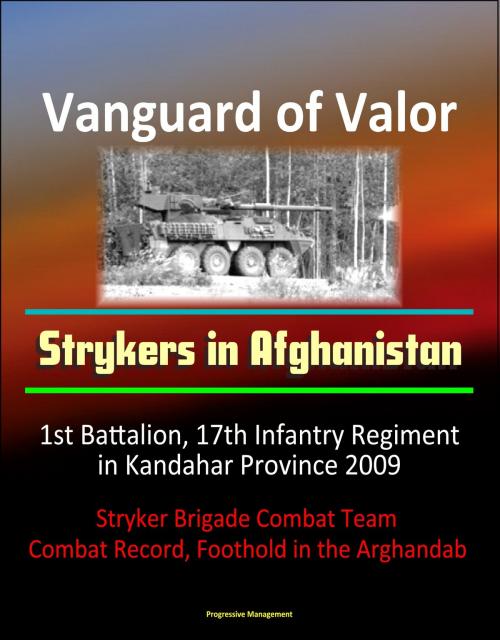Vanguard of Valor: Strykers in Afghanistan - 1st Battalion, 17th Infantry Regiment in Kandahar Province 2009 - Stryker Brigade Combat Team, Combat Record, Foothold in the Arghandab
Nonfiction, History, Military| Author: | Progressive Management | ISBN: | 9781310528613 |
| Publisher: | Progressive Management | Publication: | April 29, 2015 |
| Imprint: | Smashwords Edition | Language: | English |
| Author: | Progressive Management |
| ISBN: | 9781310528613 |
| Publisher: | Progressive Management |
| Publication: | April 29, 2015 |
| Imprint: | Smashwords Edition |
| Language: | English |
Professionally converted for accurate flowing-text e-book format reproduction, this detailed study examines the Army's first deployment of a Stryker Brigade Combat Team to Afghanistan in 2009. It created expectations similar to those common in 2004, when four Stryker-equipped battalions replaced four brigades from the 101st Airborne Division in northern Iraq. In 2009, soldiers and leaders at all levels expected Stryker-equipped formations to replicate their successes in Iraq, where they had "forged a reputation . . . for moving fast and attacking enemy strongholds all over" that country. Indeed, as the Army Times reported, planners and senior leaders in Kabul believed that introducing one or more SBCTs would perhaps revolutionize the fight against the Taliban and other insurgent groups.* And in fact, enemy forces in southern Afghanistan did struggle to find a workable response to the Strykers' speed, mobility, and high number of dismounted infantry.
Those who seek a definitive answer to the question of whether the enemy successfully adapted to the Strykers' presence or why the SBCT mission was changed before its effects against insurgent concentrations became permanent will be disappointed by this work. That question lies beyond the scope of this project. Readers will, however, find a detailed study of the initial operations of the 1st Battalion, 17th Infantry Regiment. Nicknamed the Buffaloes, the unit's operational maneuver tempo early in its deployment more than justified the brigade's deployment to Afghanistan. Shrinking time and space in the Arghandab River Valley in ways previous units could only dream of, 1-17's companies blanketed their areas of operations and significantly degraded enemy effectiveness, but at a much higher cost than originally anticipated. Despite this, the battalion made a solid contribution to the fight against the Taliban and associated elements, demonstrating again the Army's wisdom in adopting the Stryker as combat platform. More than a technical validation of the Stryker, however, 1-17's combat record demonstrated again that superior training, discipline, and creative leadership at the squad, platoon, and company level are critical factors in determining the outcome of a given engagement.
A staggered line of ten Stryker Infantry Carrier Vehicles moved across the Afghan desert at 20 miles per hour, kicking up dust as they closed on the town of Buyana in Shah Wali Kot District. On 18 August 2009, US leaders had discovered that Taliban insurgents were gathering in the small town located about 25 miles north of the city of Kandahar. American Soldiers, with their rifles and grenade launchers at the ready, stood in the Strykers' air guard hatches. They could see insurgents firing their weapons from rooftops and around corners. The center vehicle stopped at the town's western corner, while other vehicles rolled up to form a "V" Formation. The men inside the Strykers fired their mounted heavy machine guns and automatic grenade launchers, pouring rounds into the buildings while Stryker ramps lowered and teams of Soldiers dismounted to engage the enemy. Others stayed in the hatches, adding their fire to the mounted heavy weapons. The overwhelmed insurgents quickly fled the town. They had not anticipated such a quick attack. The assault marked the first to use Strykers in combat in Afghanistan.
Professionally converted for accurate flowing-text e-book format reproduction, this detailed study examines the Army's first deployment of a Stryker Brigade Combat Team to Afghanistan in 2009. It created expectations similar to those common in 2004, when four Stryker-equipped battalions replaced four brigades from the 101st Airborne Division in northern Iraq. In 2009, soldiers and leaders at all levels expected Stryker-equipped formations to replicate their successes in Iraq, where they had "forged a reputation . . . for moving fast and attacking enemy strongholds all over" that country. Indeed, as the Army Times reported, planners and senior leaders in Kabul believed that introducing one or more SBCTs would perhaps revolutionize the fight against the Taliban and other insurgent groups.* And in fact, enemy forces in southern Afghanistan did struggle to find a workable response to the Strykers' speed, mobility, and high number of dismounted infantry.
Those who seek a definitive answer to the question of whether the enemy successfully adapted to the Strykers' presence or why the SBCT mission was changed before its effects against insurgent concentrations became permanent will be disappointed by this work. That question lies beyond the scope of this project. Readers will, however, find a detailed study of the initial operations of the 1st Battalion, 17th Infantry Regiment. Nicknamed the Buffaloes, the unit's operational maneuver tempo early in its deployment more than justified the brigade's deployment to Afghanistan. Shrinking time and space in the Arghandab River Valley in ways previous units could only dream of, 1-17's companies blanketed their areas of operations and significantly degraded enemy effectiveness, but at a much higher cost than originally anticipated. Despite this, the battalion made a solid contribution to the fight against the Taliban and associated elements, demonstrating again the Army's wisdom in adopting the Stryker as combat platform. More than a technical validation of the Stryker, however, 1-17's combat record demonstrated again that superior training, discipline, and creative leadership at the squad, platoon, and company level are critical factors in determining the outcome of a given engagement.
A staggered line of ten Stryker Infantry Carrier Vehicles moved across the Afghan desert at 20 miles per hour, kicking up dust as they closed on the town of Buyana in Shah Wali Kot District. On 18 August 2009, US leaders had discovered that Taliban insurgents were gathering in the small town located about 25 miles north of the city of Kandahar. American Soldiers, with their rifles and grenade launchers at the ready, stood in the Strykers' air guard hatches. They could see insurgents firing their weapons from rooftops and around corners. The center vehicle stopped at the town's western corner, while other vehicles rolled up to form a "V" Formation. The men inside the Strykers fired their mounted heavy machine guns and automatic grenade launchers, pouring rounds into the buildings while Stryker ramps lowered and teams of Soldiers dismounted to engage the enemy. Others stayed in the hatches, adding their fire to the mounted heavy weapons. The overwhelmed insurgents quickly fled the town. They had not anticipated such a quick attack. The assault marked the first to use Strykers in combat in Afghanistan.















